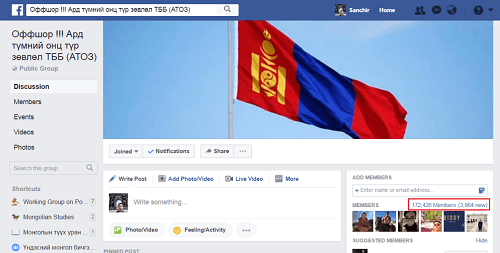Оффшор дансны эсрэг хөдөлгөөнүүд, Өрийг дахин бүтэцчилэх бодлогууд нь ОУВС болон Хятадын өөдөөс хийх өөр алхам байж болох уу?
By uczipm0, on 12 June 2017
Бичсэн: Ж. Санчир, 2017.06.06
Монгол хэл рүү хөрвүүлсэн: Ш. Номиндарь
Санчир бол Монгол төдийгүй дэлхийн Өмнөд хэсгийн улс орнуудын улс төр, эдийн засгийн хөгжлийн талаар ихэд анхааран судалдаг улс төр судлаач, нийгмийн идэвхтэн юм. Улс төрийн онол, дэлхийн улс төрийн эдийн засаг, Төв Ази болоод Орос судлалыг хамтатгасан салбар хоорондын судалгаа хийдэг түүний ажлын цар хүрээ тэгш бус, хоцронгуй хөгжлийн асуудлуудаас эхлээд пост-социалист орнуудад явагдаж буй ардчиллын үйл явц, худалдаа, хөрөнгө оруулалтын асуудлууд, олборлох аж үйлдвэр, хөгжиж буй улс орнууд дахь ядуурал, өрийн асуудлуудыг тус тус хамардаг. Шинэ Сэдвүүд Төслийн судлаачид болон монгол судлаач эрдэмтэд Санчиртай Монголын эдийн засгийн хямралыг даван туулахад гүйцэтгэх ОУВС хийгээд Хятадын үүрэг ролийн талаар цахим шуудангаар солилцсон үзэл бодлоос энэхүү нийтлэл үүдсэн билээ.
2017 оны 5 сарын 24-нд Олон Улсын Валютын Сан (ОУВС)-гийн Захирлуудын Зөвлөл Өргөтгөсөн Санхүүжилтийн Хөтөлбөр (ӨСХ)-ийн хүрээнд Монгол улсад гурван жилийн хугацаа бүхий 5,5 тэрбум ам.долларын санхүүжилт өгөх шийдвэрийг баталсан. Хэдийгээр улсын өрийнхөө хямралыг давах үүднээс Монгол ОУВС-аас санхүүжилт авахын зэрэгцээ Хятад улсаас шууд зээл авах бололцоо байсан боловч, Хятадын тал энэ тохиролцоог бүрмөсөн цуцалсан билээ. Монгол улс ОУВС-тай хийсэн энэ тохиролцоог цөөнгүй улс төрч, улс төрийн тоймч, хэвлэл мэдээллийн хэрэгслүүд хоёр мангасаас арай гайгүйг нь сонгосонтой зүйрлэцгээсэн юм.
Монголын эдийн засгийг сэргээхийн тулд нэг бол ОУВС-аас тусламж авах, эс бол Хятадаас зээл авахаас өөр арга зам байхгүй мэтээр сурталчилах нь төр засгийн болоод монопольчлогдсон хэвлэл мэдээлэлийн сурталддаг худал зүйл болохыг би сануулж байсан. Иргэний нийгмийн хэд хэдэн байгууллагууд болон миний бие зэрэг хувь хүмүүс энэ хоёрхон гарцаас бусад боломжууд байгааг дэвшүүлсээр ирсэн билээ. Эдгээрт улсын төсвөөс шамшигдуулж оффшор дансанд хийсэн мөнгийг буцааж авчрах [1], бондны эх үүсвэртэй зээлийн зарцуулалт, түгээлт хийгээд эргэн төлөлтөд аудитын шалгалт хийх, шаардлагагүй зардлыг төсвөөс хасах болон үүнтэй төстэй бусад арга хэмжээ орно. Энэхүү арга хэмжээнүүд шууд хэрэгжих боломжтой эсэх нь хоёрдугаар зэргийн ач холбогдолтой юм.
Дээр дурдсан үзэл санааг дэмжин түгээж буй Монгол дахь хамгийн том хөдөлгөөн бол Оффшорын эсрэг Ард Түмний Онц Түр Зөвлөл (АТОЗ) юм. Тэдний явуулсан хамгийн том үйл ажиллагаа бол энэ оны 3 сарын 31-нд Сүхбаатарын талбайд зохион байгуулсан жагсаал байлаа. Улсын төсвөөс хулгайлж оффшор дансанд нуусан мөнгийг авчрахыг шаардсан тус жагсаалд олон зуун хүн оролцсон бөгөөд жагсаалд оролцогч улс төрч, идэвхтэнүүд тэдгээр дансанд буй 17 тэрбум ам.долларыг буцааж авчрахыг шаардацгаасан юм. Хэдийгээр зарим хүмүүс эрх баригч бүлгийнхэний нэг хэсэг нь сөрөг талынхандаа дарамт үзүүлэхийн тулд иймэрхүү жагсаалыг санхүүжүүлж зохион байгуулдсан гэж хардаж байсан ч, гадаад орнуудад бий болсон оффшор дансны эсрэг монгол бүлгүүд болон Ард Түмний Онц Түр Зөвлөлд өгч буй олон нийтийн өндөр ач холбогдол энэ хөдөлгөөнийг ард олонд хэдийнээ хүлээн зөвшөөрөгдсөн бөгөөд бодитой сөрөг хүчин болохуйц гэдгийг нь илтгэж байна.

Оффшор дансны эсрэг хамгийн гол хөдөлгөөнүүдийн нэг АТОЗ групп фэйсбүүкт 172,426 гишүүнтэй болсон байгаа нь Монголын хүн амын хэмжээтэй харьцуулахад бага тоо биш юм.
ОУВС-тай хийсэн тохиролцоо болох Өргөтгөсөн Санхүүжилтийн Хөтөлбөрийн дагуу Монгол Улс зардлаа хэмнэж, татвар хийгээд тэтгэвэрийн насыг нэмэхийн сацуу валютын ханшийг уян хатан байлгаж, банк, санхүүгийд эрхзүйн хүчирхэг орчин бий болгох үүрэг хүлээсэн юм. Энэ бүхэн нь ОУВС-аас бусад орнуудад явуулсан стандарт бодлого болох “бүсээ чангалах” багцтай нийцэж буй бөгөөд уг бодлогыг хэрэгжүүлсэн улс орнуудын эдийн засаг агшиснаар өрийн эргэн төлөлт нь улам бүр даагдашгүй ачаа болсон байна. (Toussaint, 2010; Varoufakis, 2016; Weisbrot & Sandoval, 2007). Тийм ч учраас, миний бие Нэгдсэн Үндэстний Байгууллагын зарчимд нийцүүлэн өрийг дахин бүтэцчилэх бодлого хэрэгжүүлж, шинээр Өрийн Тогтвортой Байдлын Дүн Шинжилгээ хийж, өрийн зарим хэсгийг эргэн төлж чадах хэмжээнднь зохицуулж цайруулах, хүлээн зөвшөөрөх ёстой өр, ёсгүй өр хоёрыг ялган салгах үүднээс иргэний оролцоотой аудит хийх зэрэг алхмыг Монгол улсад хийхийн [2] төлөө тэмцсээр ирсэн билээ.
Миний бодлоор, Монгол ОУВС-аас юм уу Хятадаас тусламж авах ёстой гэдэг л сонголтууд яригдаж байгаа нь, одоо байгаа тогтолцоог эдгээр хоёр боломжийн аль аль нь савлуулахгүйтэй холбоотой. Энэ хоёр сонголт өдгөө ноёлон буй давхаргад байр сууриа хадгалж байхад нь хэрэгтэй төдийгүй энэ бололцооны ачаар эрх барьж буй төр засаг өрийн асуудлуудыг шийдэх шаардлагагүй болж байгаа юм. Тэд зөвхөн зээлийг төлөх хугацааг хойшлуулж мөн дахин санхүүжүүлснээр дараачийн засагт буруугаа тохох боломжтой болж байна. Товчхондоо, энэ нь өнөөдөр Монголыг ийм байдалд оруулсан буруутай этгээдтүүдтэй хариуцлага тооцох биш харинэрх баригчдад зөвхөн статусквогоо хадгалах л боломж олгож байна.
[1] Панамад байрлах Моссак Фонсэка хууль зүйн фирмээс алдагдсан оффшор дансны мэдээлэлд буй татвараас зайлсхийсэн, мөнгө угаасан, хууль бус шилжүүлэг хийсэн байж болзошгүй хүмүүсийн урт гэгчийн жагсаалтад хэд хэдэн орны төрийн өндөр албан тушаалтнуудын нэр олдсон. Панамын бичгүүдэд дурдагдсан Монголын 49 бизнесийн байгууллага, хувь хүмүүсийн тоонд Монголын ерөнхий сайд асан С. Баяр, С. Батболд болон парламентын гишүүн С. Баярцогт, түүнчлэн төрийн бусад албан хаагчдын нэр багтсан нь илэрсэн юм.
[2] 2016 оны 3 сард Роза Люксэмбург Стифтанг байгууллагын зохион байгуулсан Зүүний Форум, 2016 оны 7 сард Улаанбаатар хотноо зохион байгуулагдсан Ази-Европын Ард Түмний Форум болоод Ази-Номхон Далайн Судалгааны Сүлжээ, Хүнсний хувьд бие даасан байдалд хүрэхийн төлөөх Ард Түмний Эвсэл болон Хүний Эрх, Хөгжлийн Төвөөс Монголд зохион байгуулсан Ард Түмний Судалгааны Сургалтын үеэр тавьсан илтгэлүүддээ дурдаж байсныг жишээлж болно.
Зүүлт:
Toussaint, Eric. Debt, the IMF, and the World Bank: Sixty Questions, Sixty Answers.[ОУВС болон Дэлхийн Банк: 60 асуулт, 60 хариулт]. New York: Monthly Review Press, 2010.
Varoufakis, Yanis. And the Weak Suffer What They Must?: Europe’s Crisis and America’s Economic Future. [Сул доройчууд нь ядахаараа зүдрэх ёстой гэж үү?]. Washington, DC: Nation Books, 2016.
Weisbrot, Mark, and Sandoval, Luis. Argentina’s Economic Recovery: Policy Choices and Implications. [Аргентины эдийн засгийн сэргэлт: Бодлогын сонголт ба оролцоо]. New York: Center for Economic and Policy Research, October 2007, #2.
 Close
Close








